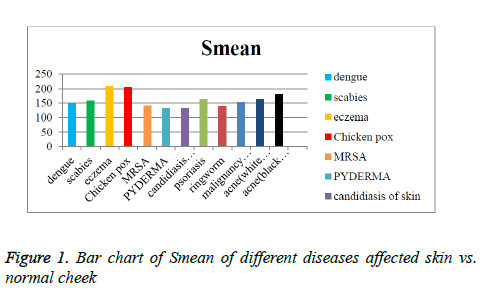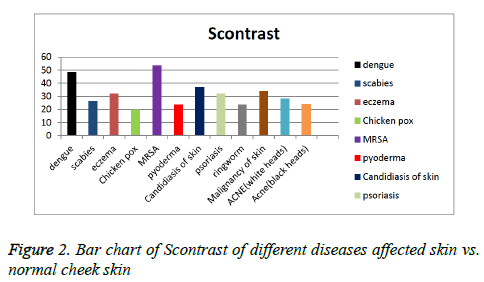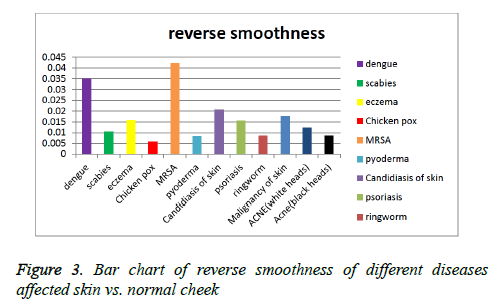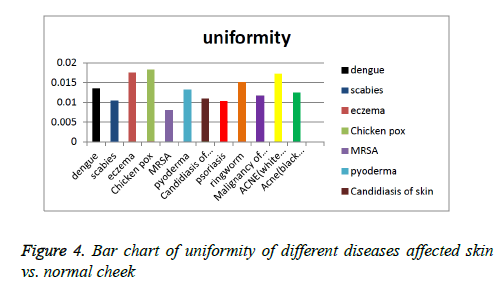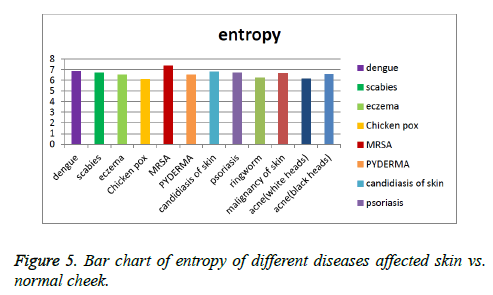Research Article - Asian Journal of Biomedical and Pharmaceutical Sciences (2017) Volume 7, Issue 60
Study and development of algorithm of different skin diseases analysis using image processing method
Nowrin Akter Surovi1*, Adnan kiber1, Abul Kashem2, Khaledun Nahar Babi2
1Department of EEE, University of Dhaka, Bangladesh
2Physical instrumentation division, Dhaka laboratory, Bangladesh Council of Scientific and Industrial Research, Dhaka, Bangladesh
Accepted date: January 02, 2017
Abstract
Tele-dermatology is a system in the medical field of dermatology where telecommunication technologies are used to exchange information concerning skin conditions over a distance. The advantage of tele-dermatology is that the patients need not to be physically present in consultation room of doctor(s). We have collected (i) eczema, scabies, pyoderma, ringworm, psoriasis, MRSA skin disease images from the American Academy of Dermatology website. Our study found that Feature Extraction is an important aspect to aid the doctors or Automatic decisions making by computer algorithm to find the diseases of the skin amongst the all possible skin diseases. Our approach was Artificial intelligence based computer algorithm that would be able to make diagnostic decision to a good degree of accuracy. We found features namely, contrast, correlation, energy, maximum probability, entropy, smoothness, homogeneity based on STATISCAL THEORY. We computed the features from the digital images of skin. We found many of the above mentioned features do vary with good degree of margin for Different Skin diseases, but few of them are barely indistinguishable.
Keywords
Tele-dermatology, Feature extraction, Statistical theory, Skin images
Introduction
In Tele-dermatology, telecommunication technologies are used to exchange information concerning skin conditions over a distance using visual image, data and audio communication [1,2]. The patients need not to be physically present in consultation room of doctor(s) in tele-dermatology. Though online tele- dermatology system has virtual feeling of presence of patient and doctor, societies like in Bangladesh with large percentage of populations are conservative, where women do feel embarrassed to expose themselves or their inner parts of body to the doctors, especially to male doctors. An offline tele-dermatology system may overcome this problem, where doctors will diagnosis the skin diseases based on sent images of diseased skin, without patient’s inner parts of diseased skin being exposed to doctors [3,4].
In such cases a computer based algorithm needs to be developed, which is capable of Automatic Analysis of the skin diseases and make diagnostic decisions, this will help dermatologists, especially in offline system as well as in online system. The above said computer algorithm requires an intelligent and smart method by which normal skin and different diseased skin can be distinguished to a good degree of accuracy Figures 1 and 2.
From the above graph of Smean, it has been noticed that there is a slight variation among different diseases. So, it may be difficult to differentiate them.
Texture analysis concerns mainly with feature extraction. Feature extraction identifies and selects a set of distinguishing features to characterize a texture in an image. By representing a complex texture with a small number of measurable features or parameters, texture analysis archives great dimension-reduction and enables automated texture processing. In the present work, different parameters of texture analysis are calculated of the normal image and Skin diseases affected images and compared. We use some matlab functions to calculate some of the above mentioned features and attributes of digital images of normal and different types of Skin diseases (Figures 3-5) [5,6].
From the above graph of Scontrast, it has been noticed that there is a big variation among different diseases. So, it may be possible to differentiate them.
Materials and Methods
In this present works, we have computed the different parameters from the skin images which characterize the textures of Images (texture descriptors) of skin. The features of skin(s) may be computed /estimated based statistical moments based features. We have computed skin features of as mentioned above for zdiseased skin.
We collect 12 different types of diseases skin from American Telemedicine Association’s website and cropping them and select only the diseases affected image. Then we determine the descriptors based on the statistical moments which are shown in the Table 1. Then we make Bar Charts for different descriptors from the graphs we see the parameters of the diseases skin are different to each other. So it a great achievement which is very helpful for doctors in making decisions about the diseases.
| Image of the diseases | Smean | Scontrast | Reverse smoothness | entropy |
|---|---|---|---|---|
| dengue | 147.34 | 48.61 | 0.035 | 6.85 |
| scabies | 158.9 | 26.26 | 0.0105 | 6.74 |
| eczema | 208.28 | 32.23 | 0.0157 | 6.52 |
| Chickenpox | 206.12 | 19.68 | 0.0059 | 6.1013 |
| MRSA | 140.73 | 53.48 | 0.0421 | 7.399 |
| pyoderma | 131.92 | 23.513 | 0.0084 | 6.5029 |
| Candidiasis ofskin | 131.20 | 36.96 | 0.0206 | 6.8048 |
| psoriasis | 163.60 | 32.062 | 0.0156 | 6.7420 |
| ringworm | 139.7 | 23.69 | 0.0086 | 6.27 |
| Malignancy ofskin | 153.47 | 34.13 | 0.0176 | 6.69 |
| ACNE(white heads) | 163.64 | 28.4054 | 0.0123 | 6.18 |
| Acne(black heads) | 181.42 | 23.8 | 0.0086 | 6.55 |
Table 1: Texture descriptors based on Statistical moments for different diseases affected skin images
From the above graph of reverse smoothness, it has been noticed that there is a large variation among different diseases. So, it may be possible to differentiate them.
Discussion
To test our proposed concepts and Algorithm for Skin diseases analysis for intelligent teledermatology system, we have collected diseased skin images namely: eczema, scabies, pyoderma, ringworm, psoriasis, MRSA , chicken pox, malignancy of skin, candidacies of skin from the American Academy of Dermatology website. We have found that Feature extraction is another very important aspect in skin diseases analysis from digital skin images.
From the above graph of uniformity, it has been noticed that there is a big variation among different diseases. So, it may be possible to differentiate them.
Our Statistical moments based algorithms were used to compute the following characteristics and features of Digital skin images namely: Smean, Scontrast, uniformity, contrast, correlation, energy, maximum probability, entropy, smoothness and homogeneity. It was found that many of the above mentioned features & Characteristics of images of different skin diseases are different, but some are very close in values, and may not use as differencing properties. However, since many of the above mentioned features are distinguishable for different skin disease, our Algorithm may be used for Automatic Analysis & Diagnosis for skin diseases to a good degree of accuracy or may help dermatologists in making his or her decisions.
From the above graph of entropy, it has been noticed that there is a slight variation among different diseases. So, it is difficult to differentiate them.
Acknowledgements
Some documents are concerned with the telemedicine and teledermatology and give definitions and descriptions related to teledermatology. To perform this thesis work, I have spent my maximum time on some standards journal and conference paper. Abderrahim Bourouisa, Ali Zerdazia, Mohammed Fehamb, Abdelhamid Bouchachia developed an a M-Health algorithm where Skin Disease can be Analyses using smart phone System Camera Paul A.J. Kolarsick, BS, Maria Ann Kolarsick, MSN, ARNP-C, and Carolyn Goodwin, APRN-BC wrote a journal about the anatomy and physiology of the skin which give me knowledge about our skin. Again we have diseased skin images namely: eczema, scabies, pyoderma, ringworm, psoriasis, MRSA, chicken pox, malignancy of skin, candidacies of skin from the American Academy of Dermatology website. We have made the algorithm of image histogram and segmentation with the help of Local Histogram Equalization with Brightness Preservation edited by Julang Jiang, Yousheng Zhang, Feng Xue, Min Hu, "Morphological image processing edited by Nick Efford.
We use different books related image processing system. The books are Digital Image Processing, Third Edition by R.C. Gonzales and R.E. Woods, Computer Graphics, Principles and Practice edited by J.D. Foley, A. van Dam, S.K. Feiner and J.F. Hughes. Introduction to Pattern Recognition: Statistical, Structural, Neural, and Fuzzy Logic Approaches edited by Menahem Friedman and Abraham Kandel, Fundamentals of Digital Image Processing edited by Anil .K Jain etc. These books are helpful to complete our paper.
References
- Random House Webster's Unabridged Dictionary. Random House, 2001.
- http://www.aad.org/public/specialty/what.htm
- Bourouisa A, Zerdazia A, Fehamb M, Bouchachiac A. M-Health: Skin Disease Analysis System using smartphone Camera. A Algeria Telecom Research Group, Bournemouth University, UK.
- Wootton R, Oakley A. Teledermatology. Royal Society of Medicine Press Ltd, 2002.
- Burg G, Soyer HP, Chimenti S. Teledermatology In: Frisch P, Burgdorf W.: EDF White Book, Skin Diseases in Europe. Berlin, 2005.
- Tuceryan M, Jain AK. Texture Analysis.1993; 2: 235-276.
